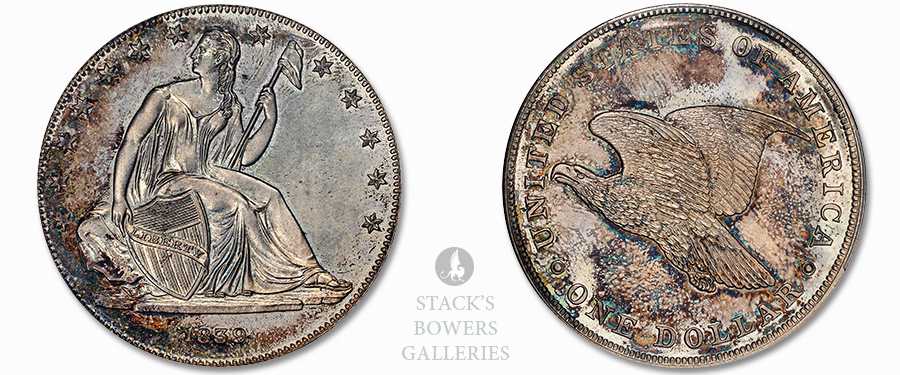
Among the numerous restrikes produced by the U.S. Mint in the late 1850s and 1860s can be found a number of Gobrecht dollars, predecessors to the Liberty Seated series, originally struck in relatively small quantities in the late 1830s. Many of the dies survived and were used to produce restrikes into the 1860s. Stack’s Bowers Galleries will be offering one of these restrikes, an 1839-dated J-104, Pollock-116 Gobrecht dollar, in the Rarities Night session of the November 2023 Whitman Winter Expo Auction. Certified Proof-65 by PCGS, it is among the finest of its die marriage graded by that service.
This issue is included in the Judd pattern book under catalog number J-104.
Both original and restrike J-104 Gobrecht dollars are known in Die Alignments III and IV, differentiated by the degree of die rust, particularly on the lettering and eagle, and the prominence of die cracks. The strike is generally sharper on restrikes though evidence of die rust is usually far more apparent. The J-104 has a reeded edge.
201 to 500 of the J-104 Gobrecht dollar were struck, according to some estimates. Experts believe that this quantity is sufficient to suggest that the coins were intended to circulate.
This Early State Restrike was likely produced sometime between 1862 and 1864. According to gobrechtdollars.com, the 1839 coins were produced by Mint Director Henry Linderman and other Mint personnel “who were restriking various pieces for profit.” All known Early State J-104 restrikes have Die Alignment III.
Gobrechtdollars.com offers this appraisal (their emphasis):
“Rust in right field at back of hand and down along forearm, eagle and letters granularity from rust, particularly noticeable on the beak, which appears very granularity.
Obverse: Small scattered rust lumps in fields of both dies. Small scattered rust lumps on LIBERTY. Earliest has rust in right field at back of hand and down along forearm. Hand at pole has a ‘hollowed’ appearance from polishing to remove the worst rust.
Reverse: Lumps between TA, elongated lump near dentils above SO. ‘Die line’ (actually a crack) from second dentil over T to left upper serif of E in UNITED, may be weakened by polishing, but visible on sharply struck pieces. Letters granularity from rusting with rust pits on upright and upper curve D United particularly noticeable on sharp strikes. Eagle rusty, particularly noticeable on the beak, which appears very granularity. Slightly later die state than the early J84 restrikes.”
Our cataloger noted this coin’s stunning appearance: “Universally brilliant, both sides reveal mirrored reflectivity, and a dusting of sandy-silver iridescence backlit by pale champagne-apricot tinting. The surfaces are enhanced by a gentle mottling of iridescent olive-russet patina that yields to vivid rose-apricot and powder blue undertones. Fully struck with razor sharp detail throughout the design, this is a lovely specimen that would serve as a highlight in even the finest numismatic cabinet.… The strong mirrors in the fields, granularity within the eagle’s beak and, most importantly, DTS die state attribution mark this Judd-104 specimen as a restrike.”
Readers interested in learning more about Gobrecht dollars of 1838-1839 are encouraged to read the Coin Resource Center’s entry: https://stacksbowers.com/coin-resource-center/us-coins/dollars/gobrecht-dollar/gobrecht-dollar-type-2-stars-obverse-no-stars-on-reverse/ To view lots in our current auctions or consign material to our upcoming sales, please visit StacksBowers.com, email Info@StacksBowers.com or call (800) 458-4646.





